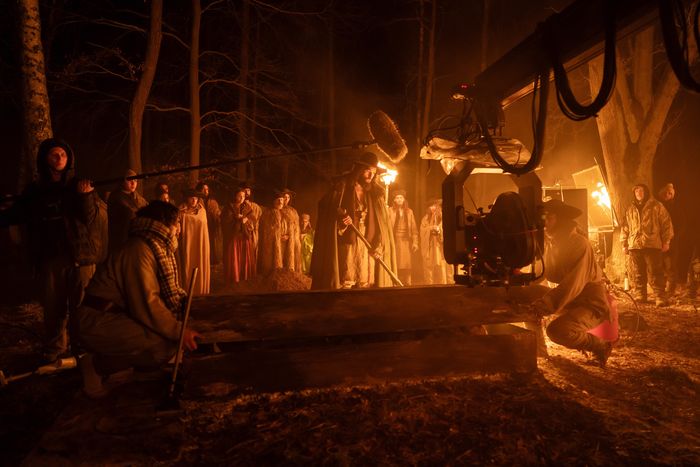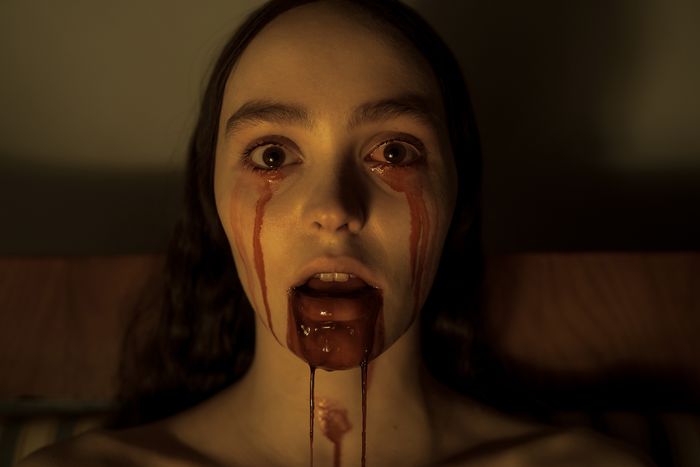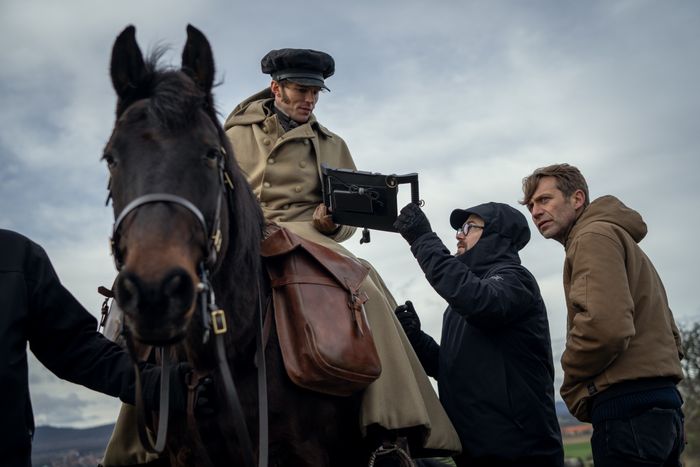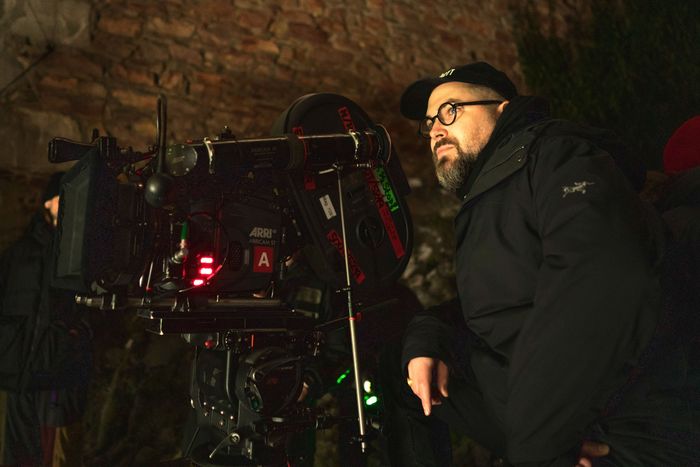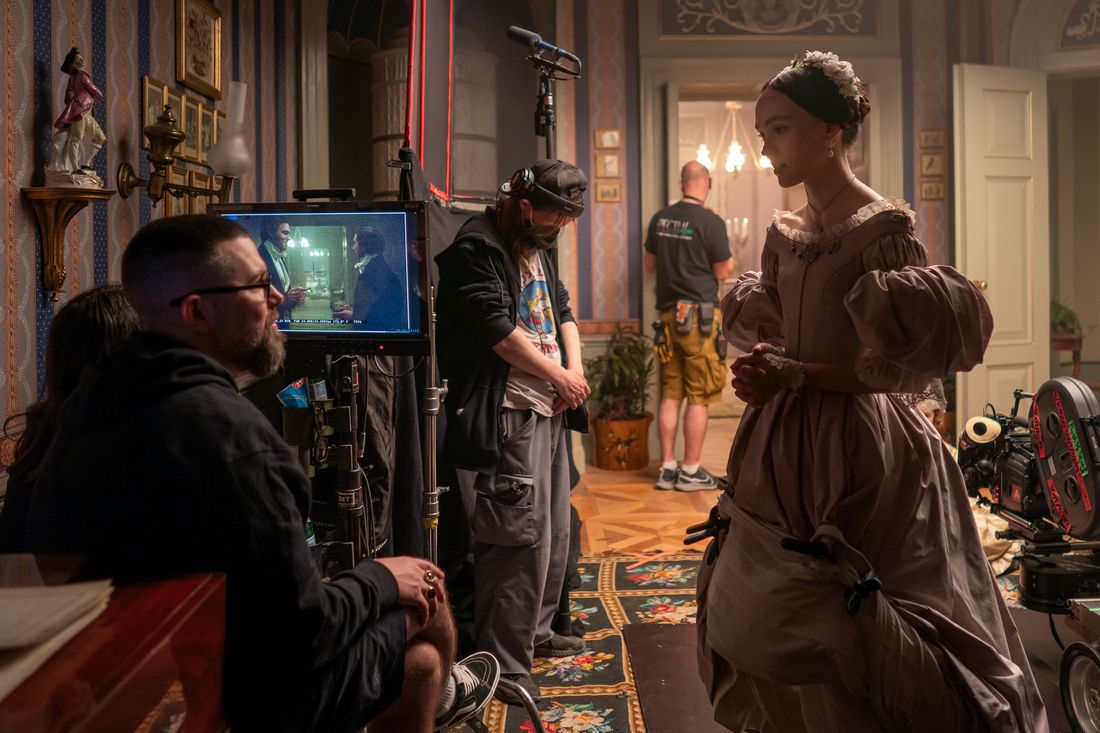
This interview was published on January 14, 2025. On January 23, Nosferatu was nominated for four Oscars.
Robert Eggers, the writer and director behind this year’s stunningly disgusting Nosferatu, was raised among books and academia. His stepfather, Walter Eggers, was an English professor and provost at the University of New Hampshire (and a film buff) and Robert subsequently became obsessed with performing and storytelling. He studied directing and design at the American Musical and Dramatic Academy, where he also made short films, channeling a childhood interest in horror and fantasy into a career focused on phantasmagorical dramas — ones that sparked arguments about what genres, if any, his work fits into.
Eggers got into feature filmmaking with his 2015 debut film, The Witch, about a Puritan family in 1630s New England besieged by misfortunes that they attribute to witchcraft and Satan. Despite a seemingly uncommercial script full of ambiguous menace that constantly intimated and never confirmed that supernatural forces were in play, The Witch earned more than ten times its $4 million budget. It established Eggers as a standout in a wave of new filmic voices that also included Ari Aster (Hereditary), Jordan Peele (Get Out, Us) and Jennifer Kent (The Babadook), all of whom, like Eggers, made bespoke personal films that were horror adjacent but weren’t exclusively interested in scaring people.
His next film, The Lighthouse, was co-written with his brother Max Eggers — a black-and-white Gothic comedy/psychological drama about a couple of miserable lighthouse keepers, played by Willem Dafoe (doing a Popeye-meets–Long John Silver performance) and Robert Pattison, who tear at each other and grow increasingly unhinged during a massive storm. Though it was a critical hit, it wasn’t a blockbuster, and further confused viewers who’d struggled to identify whether Eggers was a horror director, and if so, what kind. Eggers’s third film, the psychedelic-infused Viking adventure The Northman, was a massively scaled, $150 million retelling of the legend of Amleth that inspired William Shakespeare to write Hamlet, but with heavy-metal album-cover visuals, superlong tracking shots, and a sardonic, at times cruel sense of humor that made its brawny hero (Alexander Skarsgård) the butt of jokes.
The Northman was a box-office dud but acquired a following regardless, like The Lighthouse before it. By the time it opened in theaters, Eggers was already at work on Nosferatu, a film he’s been dreaming of doing since he was a young man. The script melds the original 1922 Nosferatu and Bram Stoker’s 1897 source novel, Dracula, and many other elements, resulting in a story that is as much of an operatic tragedy as it is a vampire saga. Eggers’s Nosferatu is hyper-controlled, ominous, sometimes opaque, and graphically repulsive. There’s little about it that’s audience-friendly, including its ending, which can be read as a nihilistic downer or a cathartic act of martyrdom, depending on the viewer’s sensibilities.
And yet it has already become Eggers’s most financially successful movie, making $135 million globally and becoming a plausible contender in Oscar categories that seldom make room for horror. We talked for over an hour in the hotel room where Eggers was staying during this year’s Academy Awards voting window. His roots as an actor were very much in evidence: Eggers is a compelling storyteller with keen comic timing, evidently proud of his work but self-deprecating, and quite skillful at replying to questions that he just said he’d rather not answer.
Do you remember the first time you saw Nosferatu, the character?
It was in a book in the elementary-school library. There was a series on different monsters, and in the vampire book there was a picture of Max Shreck, the actor who played the original Nosferatu. I thought it was the coolest thing I’d ever seen. I read the caption and wanted to watch the movie. My mom helped me track down a VHS cassette, which we had to order and that came in the mail a month later — you know, in the olden times.
When you finally got to see the movie, did it live up to whatever you’d imagined from staring at that picture in the library?
It was weird, with the exaggerated performances and everything. But it just had a believability to it, I think partially because the image was so degraded. The VHS was made from a poor 16-mm. print. There was no bald cap line on Max Shreck and no visible grease paint. It felt like something that had been unearthed from the past. And obviously, his movement, his performance, the makeup design, were all so iconic. I love seeing the restored versions of the film, because there’s clarity, and you’re like, Oh, this is tinted blue! It’s a night scene! But there is a kind of romance to that degraded VHS.
Had you seen other movie vampires prior to watching that tape?
I had seen the Bela Lugosi movie and I liked it, which is shocking to me, because I find it quite boring now — except for the beginning part in Transylvania — as great as Lugosi is. In contrast to, say, the Frank Langella movie, which is also based on a play, the Lugosi version felt more like a fairy tale. Pretty soon after I saw the original Nosferatu, the Francis Coppola movie Bram Stoker’s Dracula came out.
Which, like your Nosferatu, is hugely influenced by aesthetics of silent cinema.
The Coppola version was massive for me. I watched it a million times. When I saw the trailer, I remember thinking — and this is funny, because this is the thing that I’m constantly chasing — that this must be what the real Dracula was like. It just felt grounded in a way, more so than any other vampire movie I had seen. Gary Oldman’s performance is pretty fantastic.
What were your impressions of Oldman’s version of the character?
He seemed, in whatever sense, more realistic than, say, Lugosi or Christopher Lee or Frank Langella. I always get the impression that Dracula movies have been on this sort of evolutionary path where the vampires keep getting sexier and more conventionally human looking, and Coppola’s Dracula went in the opposite direction of Frank Langella — minus, you know, his sort of Victorian mustache and soul-patch interludes. The creature effects were really amazing, like when he turns into the bat version of himself, which is probably the only traditional jump scare in the movie.
One thing that’s kind of alarming to think about now is too-young me seeing the werewolf form of Dracula having sex with Sadie Frost. But — well, it explains a lot!
Sometimes the movie also reminded me of David Cronenberg’s version of The Fly, where the main character is gradually turning into a pile of goo, but it’s still a love story, even when he’s becoming monstrous.
Absolutely. Vampires are all about sex and death. And it’s clear that I kind of realized that as a kid. That must have been the pull towards this figure: these taboo subjects that I wasn’t talking about as a kid and didn’t understand, but that had all this power. I was also very interested in witches, of course, but they were just scary, right? Like, I never wanted to be a witch. But being a vampire had some appeal.
What was appealing about being a vampire?
Now, to be clear, I’m just saying, as a child, right? There were, you know, good costumes! Now, as an adult, I know that wearing the mask of the devil can be fun for an actor. I would personally rather play the devil than Jesus, because it’s more fun, right?
Another thing I found out watching every version of Dracula is that early vampires often didn’t drink blood. They were just as likely to smother their victims to death, or fornicate with them to death. And when they did drink blood, it would often be from the chest. If you think about it anatomically, breaking the breast bone is not very practical! But that was where the blood was taken from in early Slavic and Balkan folklore, because of sleep paralysis and the pressure you feel on your chest when you’re having waking dreams. In addition, for this film, drinking heart blood had physical, poetical appeal.
When your Nosferatu is in that form where he’s lying on top of his victims, it looks like he’s having sex with them, but he’s sort of dry humping them with these stick-like legs while sucking blood directly out of their heart.
It felt like it would be, hopefully, a horrifying image. I also knew I was going to build it so that you experience this loud, cacophonous, crazy montage of things and then silence with just the slurping, slurping, slurping. The slurping was way crazier than I imagined, thanks to the sound-design team. They took it further than I had expected.
What about his humanoid form, as Count Orlok?
That was based on this story being set in the 17th century and us asking what a Transylvanian nobleman would have worn. That’s when I knew that I was going to lean into the fact that these early folk vampires looked more like a cinematic zombie. They’re reanimated, pale, putrid corpses that are also seductive. The question was like, What would a dead Transylvanian nobleman actually look like? And so we have this Hungarian finery with incredibly long sleeves and the hat.
I knew some people wouldn’t like it. I didn’t know that the mustache would be so controversial! But there’s no 17th-century Transylvanian nobleman that didn’t have a mustache or a full beard, right? The forelock is also something you might link with Ukrainian Cossacks. It was a popular style for military warlords and aristocracy around Central and Eastern Europe in that period. The mustache by itself seemed more appropriate than the beard, because it seemed more traditionally Baltic and Slavic. And also, you know, Dracula has a mustache in the book!
What made you think of Bill Skarsgård for Nosferatu?
I’d wanted to work with Bill for quite some time, and he was originally cast as Hutter, like eight or nine years ago, or in some other part that was interesting. And then that version of Nosferatu fell apart, and Bill was cast in The Northman as this sort of foppish cousin of Alexander Skarsgård. Bill couldn’t do it because of COVID, so that part ended up being played by Gustav Lind. Then Bill wrote me a letter saying that he, like, really wanted to be in Nosferatu. I didn’t respond to it because I didn’t really know what to say or what to do. And then I happened to see It Chapter Two, and there’s a scene where he plays Pennywise as a middle-aged man, and it had a lot of weight and a lot of darkness and believability, and I emailed or texted Bill and said, “Let’s work on an audition for you as Count Orlok, because I think you can do this.”
Whose idea was the Nosferatu voice?
It was mine. In the script, which is probably available to read online now, the voice is described very specifically. I wanted Orlok to be a very imposing, phallic, masculine, demonic figure, with a voice that was both incredibly deep and commanding yet also broken, and that had these intimations of, like, broken lungs. That was something I thought about a lot: the breathing.
I sent Bill a lot of materials, including some Soviet movies with scary Balkan bad guys, with even bigger mustaches and voices so low that it sounded like they’d been smoking cigarettes since they were nine. Then Bill started working on the voice. He would send me recordings, and I’d say “a little more of this, a little less of that.” Eventually he ended up working with an Icelandic opera singer, Ásgerður Júníusdóttir, to really get the voice as low as possible.
Did you end up digitally enhancing the voice?
We didn’t. Obviously it’s louder, right? At times we push it into the subwoofers to give it as much body as possible. But we didn’t have to make it lower-pitched. I have recordings on my phone of Bill that sound the same as what you hear in the movie, but not as big as it sounds in Dolby Atmos.
It’s so interesting that you got an opera singer to work with him, because one of the words that came into my mind the first time I watched this movie was operatic. And I don’t mean in a clichéd sense, i.e., big emotions — though it has those. I mean in the sense of, when you go to an opera, just like when you go to a horror movie, you accept that the story isn’t obligated to have a happy ending, only the right ending.
As you know, it is a melodrama, and in melodrama, the emotional stakes are incredibly high. People often call the performances in the movie “stylized,” but I think the only thing that is intentionally stylized is the compositions, which are very fairy-tale-like and very precise. But, you know — and maybe I didn’t succeed! — the intention was for the performances to be naturalistic within the context of manners and customs and a way of holding yourself and conducting yourself that is of the time period. Much more mannered, more artificial and rigid in how we would conduct ourselves in our everyday life. For instance, this is a cool pose for that time if you’re sitting in a chair [sits stiffly upright with his arms shadowing the curves of the chair’s armrests], even though it seems absurd now. Someone who might want to look cool in a similar way today might sit in a chair like this [slouches into the chair with his pelvis closer to the edge of the seat and his legs splayed], right?
I asked Willem Dafoe if the word realism had any meaning to him as an actor, and he said no. What do you think?
Well, if you’re being chased by a vampire or having a hysterical fit or being possessed, what would it mean to play that realistically? And if Willem’s character seems a bit eccentric, well, so does Slavoj Zizek! If Zizek were a fictional character in a movie your first reaction might be to think he’s unrealistic.
Is it true that Willem Dafoe contacted you after seeing The Witch in a theater and told you he wanted to work with you?
That is true. And it was pretty overwhelming, because he was such a major acting hero to me while I was growing up. He still is. I was intimidated. But then — and I worry that this could sound proud or something — as soon as we started talking, I was like, Okay, I can get along with this person. We just see a lot of things the same way. When it’s a good fit, it feels like doing theater in high school with my friends.
What have you learned from Willem over the course of making three films together?
Strangely, my first answer is: doing press. He’s so intelligent, and he’s able to talk about things so clearly and lucidly and deeply. He’s able to articulate things I haven’t been able to to put my tongue on, things I’ve been reaching after for a long time but have been unable to say.
One of the best performances I’ve ever seen in my life was during press for The Lighthouse. We were backstage, about to do a Q&A, and the credits were going, with that sea shanty playing. He starts doing this [makes dancing, prancing marionette motions]. Willem starts becoming a mechanical wooden doll and doing this dance! Like a mechanical wooden doll dancing to the sea shanty. For the 13 or 15 seconds he was doing this dance, Willem was 112 percent committed to being a wooden doll. You believed it! And that’s one of the reasons why Willem Dafoe is so great.
Another thing that is particularly inspiring about Willem, though not necessarily in the work that we do together, is that he continues to stretch himself and work with first- or second-time directors, because he doesn’t want to be stagnant. He could easily have fallen into being a character actor with a voice and a shtick and a thing. But he doesn’t do that. He’s almost 70. I hope that I never get stuck, and that I’m always curious and trying to go further in my work.
How did Lily-Rose Depp end up playing Ellen?
I’d seen her in some stuff and thought she had potential, even though she’d never played a lead in a movie. Also, frankly, I thought that with her look — in this period, for that character, with her doll-like features — that if she could perform the role, the result could be really incredible. Because of the way I saw Orlok, the idea of the two of them standing next to each other was like a perfect Death and the Maiden motif.
So I gave her the script, we had an interview, and she really understood what I was trying to do and understood the character deeply. She immediately starts talking about Andrzej Żuławski’s Possession, and she had seen every major Dracula movie and even some minor ones, like Abbott and Costello Meet Frankenstein. I said, “I hope you can do this, but there’s going to be an audition, and I want to prepare you to nail the audition.” So I sent her some stuff to watch and some stuff to read. But she really did most of the preparation on her own.
What was the audition?
It was difficult. She had to do the scene where she does the monologue about the dream of death, and then she had to do a big piece of the big scene with her and Thomas, with the tongue and the brown and white striped dress. Obviously it didn’t have the technical precision that you see in the film, but it had the same raw, ferocious courageousness, that she gave physicality. She was drooling and throwing herself on the floor and I saw that she had the power to do this, that she had the will and the hunger to do this. Myself, the casting director, and even the videographer, who shouldn’t care — we were all in tears because her performance was so powerful. I can just go on about Lily’s performance forever. All of the actors had the same hunger to be there, which was the greatest gift I could ever ask for.
Nicholas Hoult’s portrayal of fear is quite remarkable.
It really is. Nick saw the challenge in the role. It doesn’t have the showiness of Lily and Bill, but it is very, very challenging, and kind of unforgiving. In the final act, he’s playing the hero as strong as he possibly can, but the character is failing, failing, failing, you know? That’s not easy to to do.
How would you characterize the ending of this movie?
Sorry to be a film director, but it’s not for me to say. I’m hoping for it to be a nuanced ending that people can take different things away from. Part of the reason why I like archetypal stories is that they can be interpreted in different ways by different people in the same audience.
The first time I saw The Witch, I came out of it wondering how literally I was supposed to take that ending. I find that all of your movies are that way, to some extent.
Thank you. I’m spending two months just talking about the movie, and it’s a weird dance.
Do you wish you could be Terrence Malick and not give interviews?
Yeah, yeah. I mean, in a perfect world. But it’s not a perfect world, right? So there is value in trying to sell your movie, or whatever.
But ultimately, as far as the end of The Witch, it’s real if you believe it is real. And that’s sort of the stance for the characters in my films.
Willem also said that one of the things that drew him to your work is that you don’t gently hold the audience’s hand when you’re taking them into another period or another way of seeing the world. They’re thrown into the deep end of the pool. I don’t believe there’s any character in any of your movies that represents the modern point of view on anything.
Certainly that’s my intention. It’s impossible to completely divorce myself from my contemporary lens, but I try, as much as it’s humanly possible. I mean, obviously, in Nosferatu, Nicholas Hoult’s character is fairly relatable, and the Harding family is fairly relatable, but they still have their own 19th-century belief system and code of ethics. Going back to The Witch, what you’re talking about, with the period — that was a challenge, because in the beginning of the movie, when the baby disappears, among the audience there was a lot of, “Why aren’t they searching for the child?” It’s because they know that there’s no hope. In the 17th century, you were told not to form close relationships with your children until they were 7, because they were probably going to die.
Let’s talk about the power dynamics of gender as presented in Nosferatu. Again, to Willem’s point, nobody represents a 21st-century point of view. There are no proto-suffragettes who fence. You can feel how, for a woman, this society is as constricting as a corset.
Well, in the original Nosferatu, Ellen’s story was important. F.W. Murnau and his collaborators had the sensitivity to make Ellen the heroine by the end of the film. But I felt that if I told a story through her eyes, there would be the potential for a more emotionally and psychologically complex story, something more interesting than an adventure story about a real-estate agent.
It would have been easy to have Lily put on her husband’s trousers and go out and personally stake the vampire. But I thought it was more interesting to see a woman with this deep understanding of the dark side of humanity and a connection to another realm who is not able to have these characteristics cultivated — a woman who is shut down and told she’s mad and hysterical, turning into someone with with agency in a world where she can’t have it, and she’s constantly fighting against being told no. She says, “I have to find him,” but she’s not allowed to even just leave the men’s sight, and she’s literally tied down to the bed.
There are divided opinions as to whether Ellen is a heroine who makes a bold choice or a woman doomed from childhood who has no real agency, stuck in an innately misogynistic subgenre of story. She sacrifices herself for the good of the city, and humanity, and succumbs to the vampire. But some have said that the movie never really overcomes a strain of misogyny in the source materials.
I was asked by a journalist the other night if I ever considered a version where Ellen didn’t have to sacrifice herself. I said, “I’ve given it a lot of thought, and obviously I’m aware of all of the feminist literary criticism talking about Victorian authors who write these stories about women who are sexualized and who then need to be punished by their male authors, unconsciously, for being sexualized.” But there is another school of feminist literary criticism, saying, “But isn’t it interesting that this female archetype who understands the dark side of humanity and is sexualized keeps being reconstituted as the savior of Victorian culture?”
So she dies not for her sins, but for our sins?
She dies for our sins, in a way, yeah. I think there is a sacrifice. But there is also vengeance, and there is also a weird kind of sacred marriage, in a union sense, and a sort of completion of some kind of destiny, because as much as Orlok is a disgusting abuser, he’s the only person who can understand and fulfill a part of Ellen. Hopefully there’s nuance going on there, and it’s not just this or that.
Orlok is a monster, and this film is a story of an underage girl who was a victim of rape.
Absolutely, there is that. And, while this is less horrifying than what you just addressed, this is also a demon-lover story, like Cathy and Heathcliff in Wuthering Heights. Is Heathcliff really interested in Cathy, or does he want to possess and destroy her? You’re drawn into that story, but it certainly is not a healthy relationship.
What do you gain by denying people a modern anchor in historical fiction?
The ability for people to have these kinds of conversations. I was working on something with a contemporary prologue, and I found myself quite stuck, because I was wondering, Do I need to address that? Do I need to address this? What about this thing, and that thing, and the other? I think that by fully realizing a past culture, to the best of my ability, we can read into it all kinds of things about who we are, or where we’re going, and there’s always room for people to get out of it what they want, and it’s freeing for me as a storyteller.
One of the key questions in the movie is, does evil come from without or from within? I’m not sure if you ever actually answer that in the movie, but I can kind of see it from both directions.
I’d rather provoke those kinds of questions than answer them. But I think the answer is both.
The modern mind rebels at the idea of evil being a disembodied force that can enter us. How do you grapple with an idea like that, as somebody who, as you say, can’t entirely escape their modern mind?
Well, that’s what I like: If you believe it, it’s real, you know? And that’s part of why I like to explore these things in my films, instead of practicing ritual magic in my library.
If you came across the Necronomicon, would you read aloud from it or close the book?
I wouldn’t read aloud, but I might give it a noodle.
Is one of your goals when you make a horror film to scare people, in the super-basic “Boo!” sense?
Sure. We have a few jump scares in this film because I felt that because Nosferatu sort of invented horror movies in many ways, and we are having a conversation with horror history, it was important to have some story-motivated jump scares.
There’s a strain of thought that holds that if you’re not jumping out of your seat, it’s not a real horror film, and I wondered what you thought of that.
I think what’s interesting about horror stories goes to Ellen’s question in the film. You’re examining the darkness within ourselves, not just inside you or me, but as humans, as a society. There is real value in that. Also, a jump scare can be satisfying, but it doesn’t mean a lot. The best part of it is the relief of tension in the audience. But I think what really makes a movie scary is all the moments leading up to that. You’re on edge the whole time, and concerned that anything is possible. The feeling that anything is possible is part of what makes monsters scary.
More on Nosferatu
- Shouldn’t Nosferatu Be Scarier?
- Nosferatu’s Final Moment Is an Act of Consent
- Everything You Ever Wanted to Know About the Rats in Nosferatu



